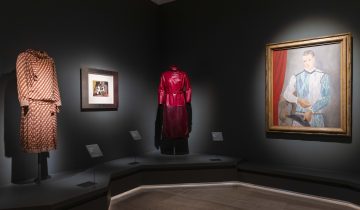As court sculptor and the first woman royal sculptor recorded in Spain, Luisa Roldán reached the top of her profession.
8 September 1652, Seville – 10 January 1706, Madrid
Luisa Ignacia Roldán, better known as ‘La Roldana’, was trained in the rich artistic milieu of Seville in the second half of the seventeenth century. She became the only woman ever to be appointed to the role of “escultor de cámara,” the highest court position in Spanish baroque sculpture. Luisa was the daughter of the famous sculptor Pedro Roldan, and she and her siblings must have worked with him on many commissions. Her early life was spent in Andalusia, mainly in Seville – where she completed her apprenticeship and married – and then briefly in Cadiz. In 1689 she moved with her husband to Madrid where she became court sculptor, remaining there until her death in 1706. Despite great professional recognition in Spain and Italy, where she was named Académica de Mérito by the Accademia di San Luca, Luisa died in penury.
Marrying the sculptor Luis Antonio de los Arcos (also an apprentice in Pedro Roldán’s workshop) in 1671, Luisa and her husband began to work as an independent team. They produced works for churches, convents and confraternities in Seville and other Andalusian provinces, and the large number of commissions they received from the 1680s onwards indicate that Roldán had by then made a significant mark. The year 1684 saw the couple’s first well-documented work, the Ecce Homo in Cadiz Cathedral, their names were recorded in a document found inside the sculpture during restoration. The esteem in which this work was held caused the cathedral Chapter in 1687 to commission the couple to produce sculptures of the patron saints of the city, Servandus and Germain. These works are also dated to 1687 according to documents deposited inside them.
With this experience and thanks to the success reaped in Cadiz, the couple left Andalusia permanently for Madrid in 1689. Although it is not known what was behind the move, it may have been – as Palomino said – at the invitation of Cristobál de Ontañón, valet of Charles II. Working at court offered unparalleled opportunities for economic and social advancement. Some of the most important works produced during this period were in wood, but what has attracted most admiration are Roldan’s small polychromed terracotta figure-groups. Thanks to the speed with which these could be executed, Roldán made a large number, responding to the demand for small- format sculpture for oratories and domestic settings. There are many examples of these groups in convents, museums and private collections in Spain and elsewhere, some of them signed and dated.
The first documented work from the period in Madrid is the Rest on the Flight into Egypt in the collection of the Conde de San Pedro de Ruiseñada, signed and dated 1691. This was followed by the Mystic Marriage of Saint Catherine at the Hispanic Society in New York. In 1692 Roldán achieved what no other woman in the history of Spanish art has done since: she was named “escultora de cámara,” first of Charles II, and then of the new Bourbon king, Philip V. In the same year she signed two important works in wood – Saint Michael commissioned by Charles II for the Escorial, and the Saint Ginés de la Jara now in the J. P. Getty Museum in Los Angeles – as well as and the terracotta Virgin and Child with Saint John the Baptist now in Chicago.
Amongst other signed and dated works in terracotta are the Virgin Sewing from 1692 (now in a private collection); the Virgin and Child from the convent of the Teresas in Seville in 1699; and the Nativity with Saints Gabriel and Michael (also in a private collection) dated 1701. There are also several figure-groups with scenes from the lives of Jesus and the Virgin such as the Virgin and Child with Saint San Diego de Alcalá in the Victoria and Albert Museum in London; the Virgin and Child with Saint Simon Stock in the Museu do Patudos, Alpiarça, Portugal; Saint Joachim and Saint Anne with the Newborn Virgin (fig. 1) and the Holy Family with the Christ Child taking his first steps in the Museo de Guadalajara3; the Education of the Virgin in a private collection; and the Education of the Virgin in the Freiherr F. von Stum collection in Berlin.
The last acquisition of the Ministry of Culture in 2022 for the collection of the National Museum of Sculpture in Valladolid was the Virgin of the Milk, C. made between 1689-1706 in terracotta and polychrome, sold by María Cortés and from a private collection in Madrid.

8 September 1652, Seville – 01 January 1706, Madrid
Virgin of the Milk, C. 1689-1706
Fired and polychrome earthenware, 38 x 23 x 20 cm.
Acquired by the National Sculpture Museum of Valladolid. Sold by María Cortés from a private collection in Madrid.



 No products in the cart.
No products in the cart.